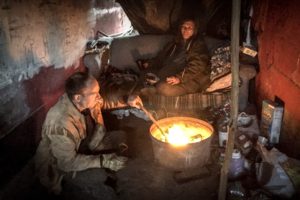Homeless In Oskaloosa

David and Lora Foreman have been homeless on the streets of Oskaloosa for over a month. They call a small bridge, or culvert, home.
Oskaloosa, Iowa – The extreme cold and wind of winter have many in Iowa ducking for the warmth of home. Most residents in Oskaloosa appreciate and enjoy the safety that the warmth that their furnace provides them, along with the ability to open the refrigerator and cook their meals.
There is another group of individuals that struggle to find shelter from those winds and extreme cold. A doorway in an alley can help to provide some measure of protection from the wind, but not the cold.
The homeless population in Oskaloosa often goes unnoticed, except an occasional cart piled with scraps collected from dumpsters and curbsides.
Those items allow for some individuals to barter, trade, and sell scrap metal to obtain the things they need and want.
There are many reasons people are homeless, including mental illness, drug addiction, bad luck, and for some, it’s a choice to be homeless.
Lora Foreman and her husband David are homeless, and as of this interview, are living under a small bridge within the city limits of Oskaloosa.
Lora says that her path to homelessness started when the apartment they were living in needed to be repaired, and they couldn’t find a place to move within the two months of notice. “They inspected the building, and it was falling in.”
Lora said that she left behind family heirlooms when her and her husband left to live on the street. “It’s just messed up,” explained Lora, as she begins to break down in tears.
“Two months ain’t enough time to find anything,” explained Lora. “We carried what we can carry.”
Lora isn’t without an income. She gets SSI and Social Security, something that she says left her to being preyed upon by others when they became homeless. She says that some people took them in at first, but then threw her husband out and kept her trapped in the home in order to collect money from her.
According to Lora, she recently became her own payee for her government benefits and said that she’s been on disability most of her life. “I recuperated enough that I can manage my own money. I can pay bills. That’s a piece of cake.”
Lora and her husband were able to reunite, but they couldn’t find an apartment, “because we had nothing. We only get paid once a month.”
From that situation, Lora and David found their way to a secluded spot in the woods within Oskaloosa. “That north and south wind going through there get so awful cold.”
“We’ve been camping outside of town. About two miles I’ve been walking every day, hoping and praying something will work,” says Lora, looking straight ahead.
“I’m just at my wit’s end. I’m tired of being hungry. I’m tired of being cold, because people care more about money than they do a human life,” said Lora. “We’re doing the best that we can to survive.”
Lora says that one of them has to stay at their camp because other homeless people will enter their camp and steal what little resources they have. She visits Penn Central Mall to get water and then walks back to the camp.

Lora Foreman apologized for being so dirty when we went to take her picture. Her and her husband David have been living under a bridge in Oskaloosa for approximately a month.
“Nobody cares. When you’ve got money, that’s all people care about,” explains Lora. “They don’t care about human life, and that’s terrible.”
Since becoming homeless, Lora says people treat her, “like dirt, and worse. I’ve got no time for you; you ain’t nothing, you ain’t got nothing, you ain’t nothin’.”
“I’m a good person you know. I’m honest, I don’t lie, I don’t steal. I’d rather starve to death than steal a candy bar,” said Lora. “I never ever really thought the world would come to this.”
Lora smokes cigarettes, and she picks up receipts off the floor from other people’s purchases in order to roll her own cigarettes. “Because I ain’t got a dollar seven to go and get a pack of papers. I roll my own cigarettes because it’s twenty dollars for a bag of tobacco.”
“It’s like we are excluded from society, because of the way we are,” said Lora.
“You know where that place is that’s suppose to help people? They don’t,” said Lora. “They give you a piece of paper and tell you to make calls.”
Lora explained that they do have four blankets given to them by Mahaska County United Way.
Lora says that they continue to look for a place to call home, but she explains that the line to get an apartment is lengthy. “People are already in line. It’s already set up for them.”
The couple is now discouraged and leary of landlords. “We’re just doing the best we can to survive January, February, and March, doing what we need to do until we can get up enough money saved.”
“Finding a place seems endless, because nobody wants to rent to us,” explained Lora. “We have no help.”
Lora says she has health problems, “my health is so bad, it’s only by the grace of God that I’m still here.”
I asked Lora if I could take her picture. “I’m sorry I’m so dirty and everything,” she says. “I was blacker when I got here.”
A coughing spell hits Lora as she sits while I take her picture. She grabs for a cup, taking a drink, and explains that it’s tea she made over the fire at their camp.
“If something doesn’t happen soon, I’m going to die out there,” says Lora. “We had some luck. We did find a tarp and some plastic. We almost got asphyxiated because of the smoke, as we tried to keep warm.”
Lora continues to cough as she explains that they walk the woods collecting firewood, and that she was waiting for her government money to arrive so she can buy David a pair of boots, because the soles were falling off of his. “I’m just exhausted.”
Lora said that they do experience some generosity, like the previous day, a local pastor bought her lunch at Pizza Ranch. She admits that she took five or six pieces of chicken back to camp with her, because David hadn’t had anything to eat.
David guards the camp during the day. Lora says that other homeless people will attempt to steal her medications, with some of her medication disappearing recently when they were both away. “That’s why only one of us can come in.”
When it comes to their situation, Lora says they have nothing to hide. “We’re only trying to survive, and doing our best to keep God in our hearts.”
Kim Newendorp, Director of Mahaska County General Assistance located at the Mahaska County Annex, works to keep people from becoming homeless.
Homeless people are not only those living on the street. Other homeless people can be found on friends and families couches or living in their cars. There are also many homeless high school students. Once they turn 18, parents may make the student leave their home.
Newendorp is often that point person for someone who is about to become homeless. “Once they are homeless, I can’t assist them with any monetary assistance.”
“According to the code of Iowa, the only assistance I can give is up to a maximum of $200 per family to help them not to become homeless,” explained Newendorp. “I don’t do deposits, and I don’t do first month’s assistance on anything.”
“So what I help with is hopefully to prevent you from getting homeless if you lost a job, but are actively seeking a new job,” explained Newendorp. “A little help to get over the rough patch.”
Beyond Mahaska County Relief, Newendorp is able to refer those in need to other agencies in Oskaloosa that may be able to help.
Those include the Homelessness Coalition, Love Inc, and the Salvation Army. SEIDA helps those with lower income to pay gas and electricity bills. HUD may also be of assistance in some situations.
Newendorp says she also encourages the use of the Ecumenical Cupboard if having enough food is an issue.
Every agency has limits to their ability to help. Some of those limits are imposed by law, such as county relief. Other limits may be in the agency’s rules, while other agencies are limited in how much money they have to help those in need.
Newendorp says that some of the increase in homelessness can be traced back to the recent adoption of a rental inspection program implemented by the city of Oskaloosa.
That program is only but one part of the reason more Oskaloosa individuals are finding themselves on the street. Newendorp says that recent business closings have also played a factor in the increase of homelessness.
Nearly half of all students in the Oskaloosa public school system are eligible for free or reduced lunch. For a child to be eligible for a free lunch, a student’s family income must be under $15,171 (latest numbers are from 2015). To receive a reduced lunch, the income must be under $21,590 (also from 2015).
Newendorp says that a search of online job postings shows opportunity for employment in Oskaloosa. Those jobs may require different education or experience that what a homeless person may have.
Newendorp says that homeless individuals that do find a job then face the problem of hygiene. Where to take a shower and do your laundry while you are still living on the street, attempting to save enough to move into an apartment.
Transportation or lack of transportation is another major hurdle some homeless individuals may face.
Making sure you are at your job on time can also be a struggle for a homeless individual. “Some people may not even have an alarm clock or a watch. So how do you know what time to be at work,” said Newendorp.
Newendorp said that if the resources available in the county are utilized correctly, there is potential to help lift someone out of homelessness, but there is no magic bullet that fixes the situation for those being impacted.
“No one’s just going to come and hand you everything to do it [get off the street],” added Newendorp. “And it is significant work.”
The homeless situation in Oskaloosa is impacting those of all economic and educational backgrounds. The key to not ending up on the street is to reach out for assistance beforehand.
Access to the internet is another struggle for those that are homeless. The library does have access that is open to the public, but security settings on the computer or the lack of understanding by the user also impact the results.
Newendorp says she is often asked if employers have paper applications, which is often met with an ‘I don’t know.’
“There are so many factors working against the homeless when you’ve truly gotten to that point,” said Newendorp.
Many homeless lack that person that helps guide them through the process of getting off the street, pointing them towards the needed resources. “Once you fall down that far, there’s no way to get yourself back up,” said Newendorp.
An address and phone number are important resources in order to keep government assistance. If you miss reporting or can’t communicate with those programs, you risk being denied benefits.
Amy Meyer is a member of the Mahaska County Homelessness Coalition. She is also the director of the United Way of Mahaska County.
Meyer said homeless individuals are those without permanent residency. “So it could be someone who is going from home to home.”
Meyer says that there is a great effort to help individuals from becoming homeless. Organizations like the Homelessness Coalition, Love Inc, the Salvation Army, and in some cases Crisis Intervention are those partner agencies.
The YMCA in Oskaloosa also works with the homelessness coalition to get day passes so individuals can get a shower and clean up.
For those with mental illness, a visit with Heather Gross, the Coordinator of Disability Services in Mahaska County, may also find resources to help. She is also located in the Mahaska County Annex building.
“A lot of times, we can come together to get a deposit and first month’s rent,” said Meyer. First month’s rent and the deposit could easily be $1000 or more and would be a barrier for many trying to get into an apartment.

There are several homeless people living in their cars in the Mahaska County area. Drugs and alcohol are sometimes factors in the homeless situation.
But in order for that assistance to happen, the groups would need to know that the individual or family would be able to continue paying the rent. Otherwise, they would be back on the streets within a month.
The trouble for the homeless then continues full circle. Without a place to clean up, clean clothes, make phone calls, receive mail, and in many cases have internet access, employment eludes them. Without the steady income, the problems continue.
The homelessness coalition and the other agencies do work to get the homeless into motel rooms when safety is an issue, especially during brutally cold times. “There were people who have lived on the street for years, which we put in a hotel,” said Meyer of the groups efforts to protect those individuals during the coldest parts of winter.
The closest shelter for the homeless is in Des Moines, and the groups do help with transportation to there, or also help with transportation to a family member that is willing to help and take them in.
The answer to helping people move from being homeless to having a home isn’t an easy one.
Barriers include having a phone number, having an address, having a shower and clean clothes. These are just a few of the many steps it takes to help individuals transition off the street.
Each situation is unique. It could be something like getting a birth certificate so that they can get a license. Providing the simple things like that, or receiving mail for individuals, or use the phone, or receive a fax are all things they do to help. “We do want to act as that resource for people, just as a permanent place that they can use.”
“With limited resources, we don’t want to have to pay for a night in a hotel if all they need is a shower to go to a job interview, they can actually go and get that at the Y,” said Meyer of the cooperation between the entities to provide assistance.
“There are a lot of different moving pieces that I think the agencies work really well together to try to meet. I guess the thing I always come back to is it’s just so much more complicated it seems. People are quick to say, why isn’t anyone putting them in an apartment”, said Meyer, who explained that it’s not always a simple thing to do.
Meyer is familiar with the situation that Lora and David Foreman are in. The couple does have money, but the problem is then overcoming the barriers “to find an apartment that meets their needs. Which sometimes is not having a place to go, even if you have the money.”
“Even just finding a place can be overwhelming,” said Meyer. “Especially once you’ve been out on the street for a little bit. It can feel overwhelming to meet those steps again.”
That feeling of being overwhelmed by it all is something Lora expressed during her interview.
Meyer said many of the homeless she comes in contact with are in the position “because things came off the track,” and many times comes down to mental health or addiction.
“There’s not a lot of short-term wins,” says Meyer of the effort to help individuals get off the street.
Meyer said that the best way people can help the homelessness coalition is through a financial contribution. “We run out of money, several times a year.”
The coalition receives most of their money from the United Way, and have had to ask for advances on their United Way funds, “because we don’t have enough money to continue to meet needs,” added Meyer.
Beyond the dollars, Meyer says the coalition is in need of volunteers. “We, right now, have a pretty small group.”
Meyer said that even if you feel like you don’t know what to do to help the homeless, “We all started off that way. None of us have formal training in this.”
Under the bridge, Lora and David invited me in to share a glimpse of their life on the streets of Oskaloosa for the past month.
The sight and smell made me think of some third world country when I opened the tarp to their living space.
A fire ring serves as both heat and a place to cook. A sofa gives them a place to sleep and some shelter from the wind.
A donation earlier in the day allowed them to get some hamburger and a little coffee for supper.
The thick smoke generated by the fire in the middle of the space they are in permeates everything, quickly attaching itself to your clothing and your skin.
The pair continues to cough heavily from the smoke but they more concerned with staying warm against the brutal January wind. “Unfortunately, we just don’t have anywhere else to go.”
“They [help groups] give us three papers saying you can do this or do that, but they got so many lines of people,” says Lora.
Their life, for now, will see them living on the streets until a solution presents itself. It will take a lot of work from all involved to make that solution possible.
To donate to the Mahaska County Homelessness Coalition, you can mail your donation to 500 High Avenue West in Oskaloosa. Volunteers are also welcome and needed.












